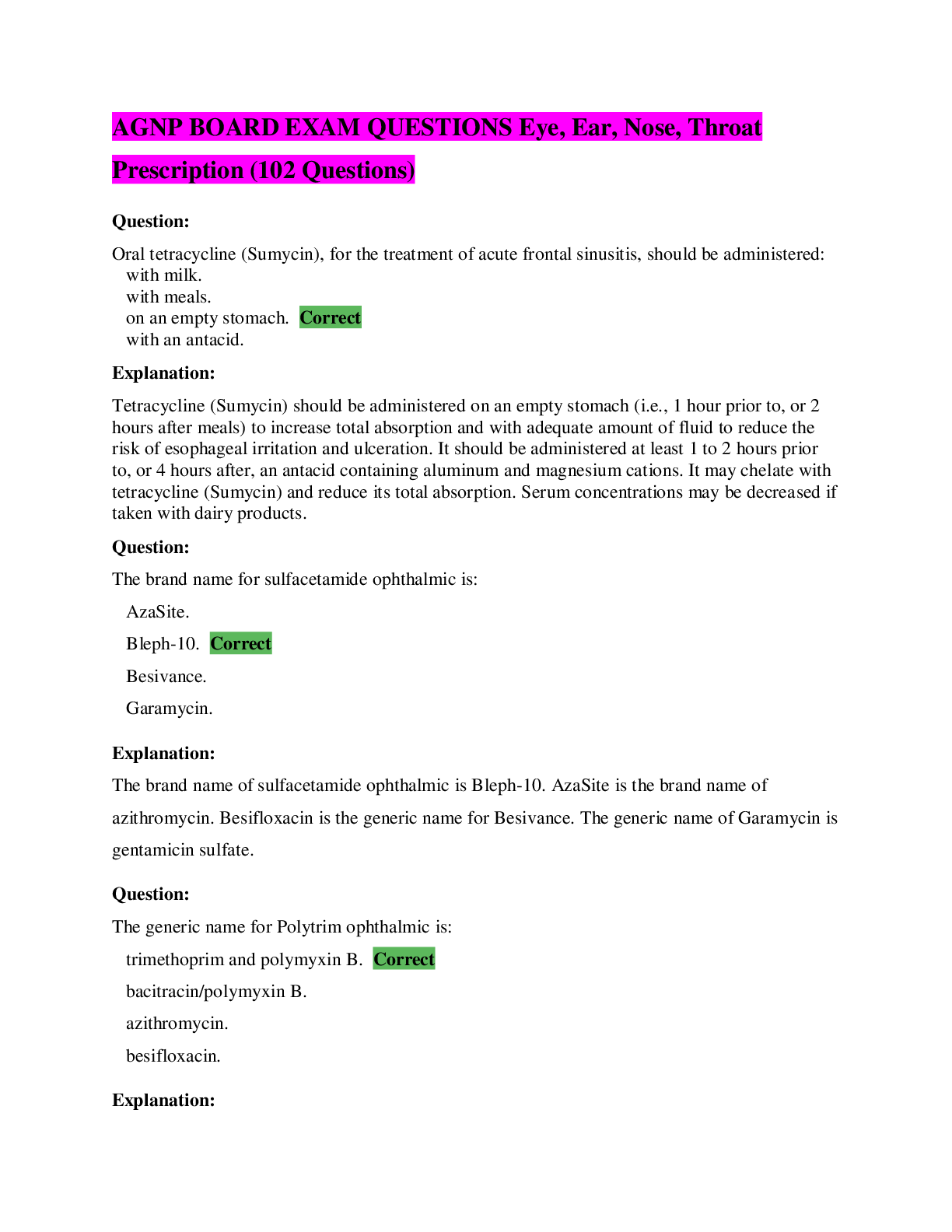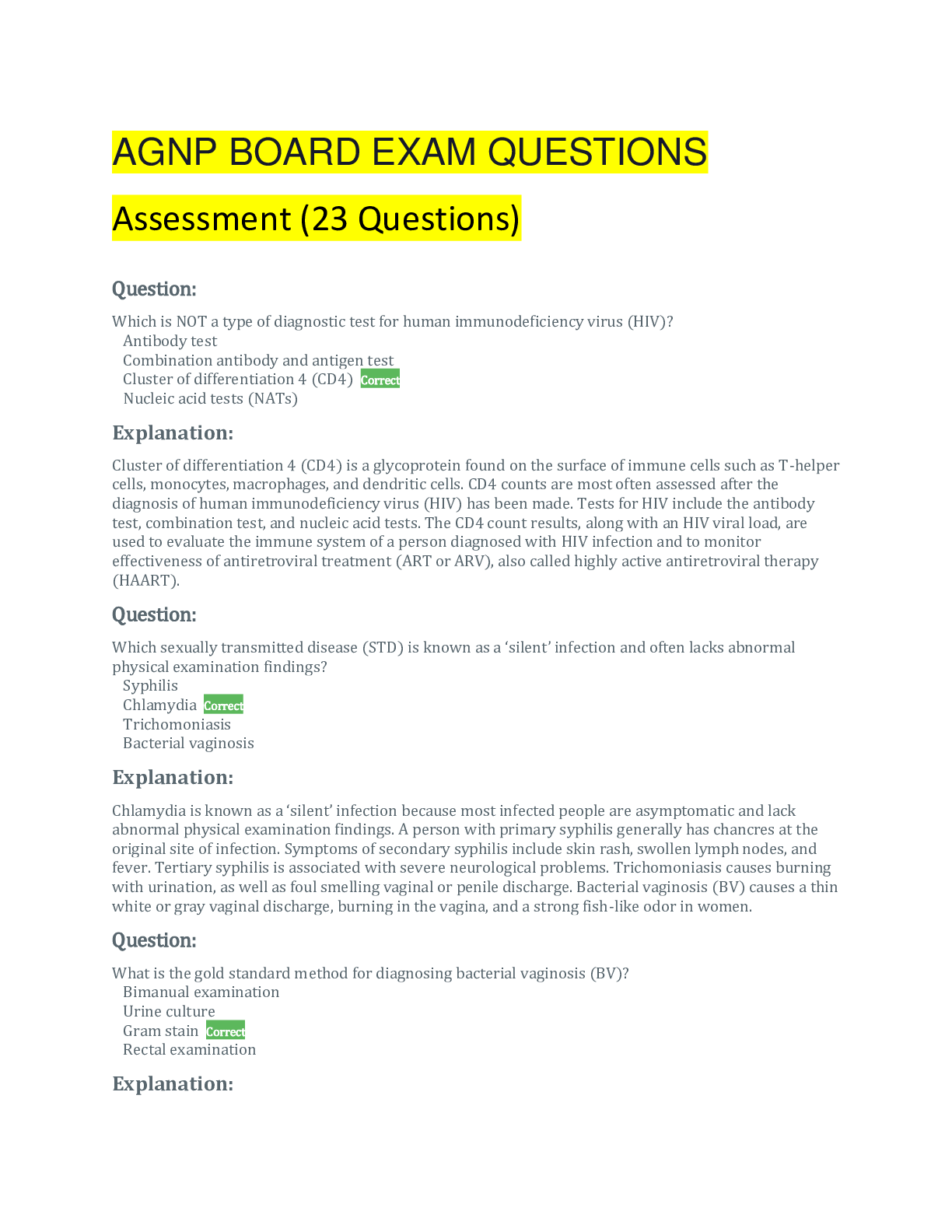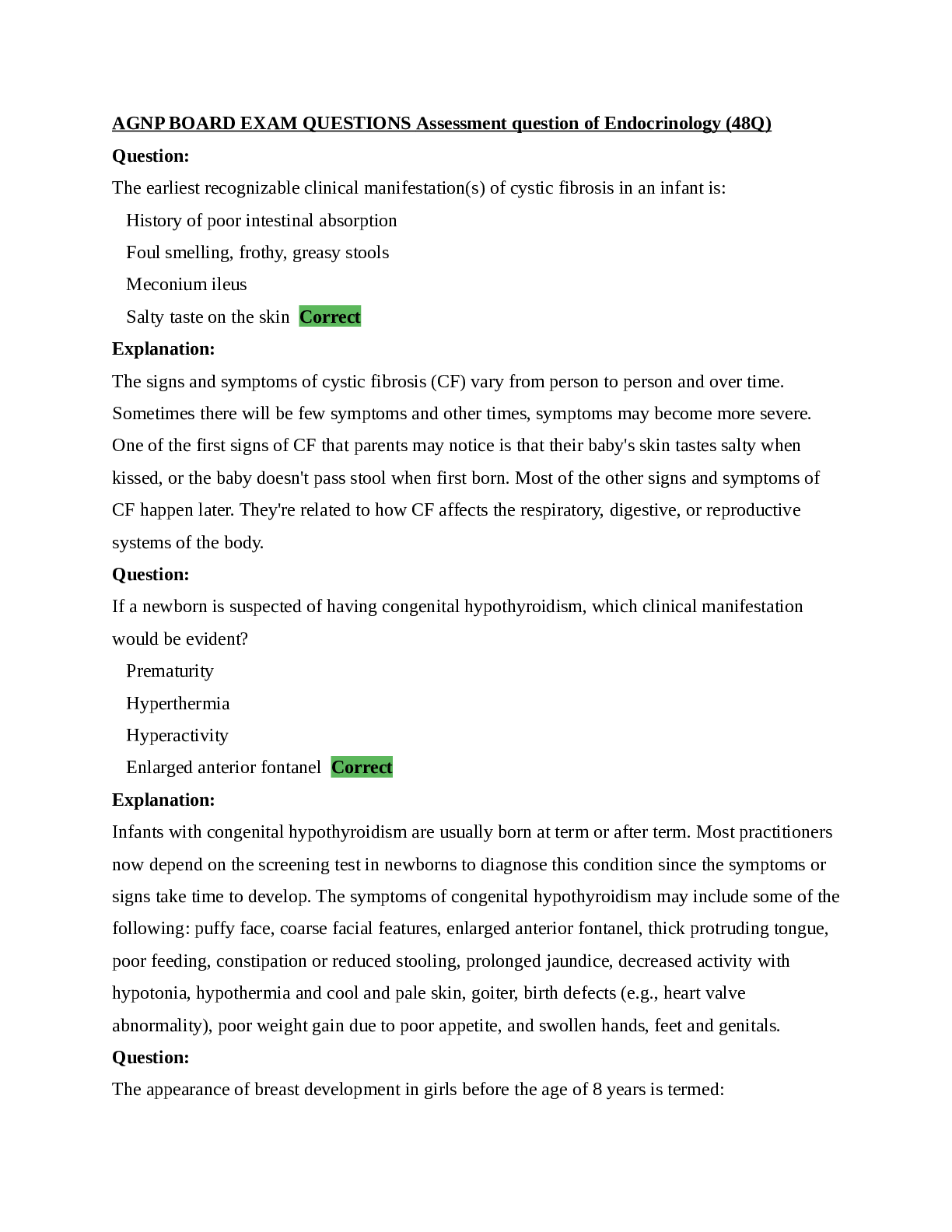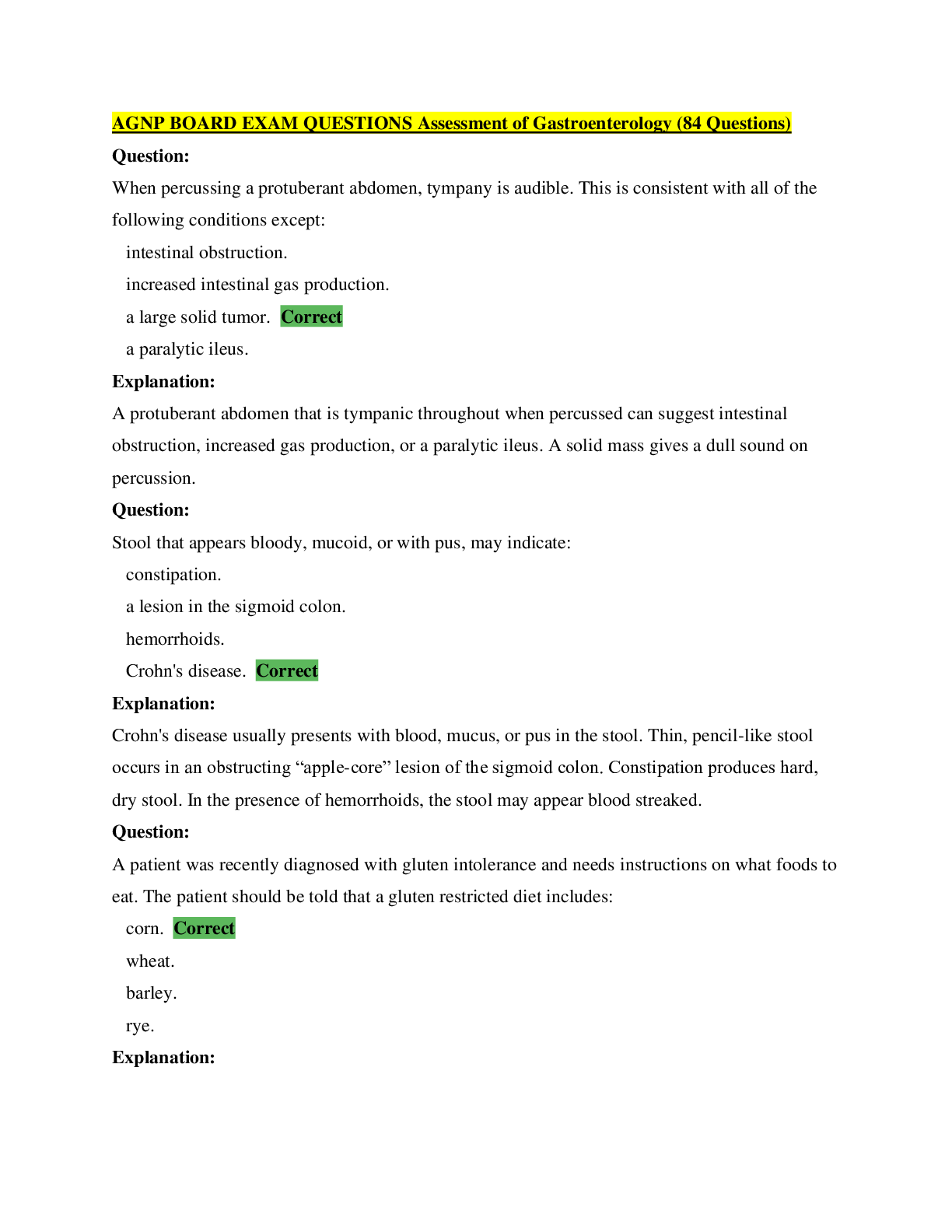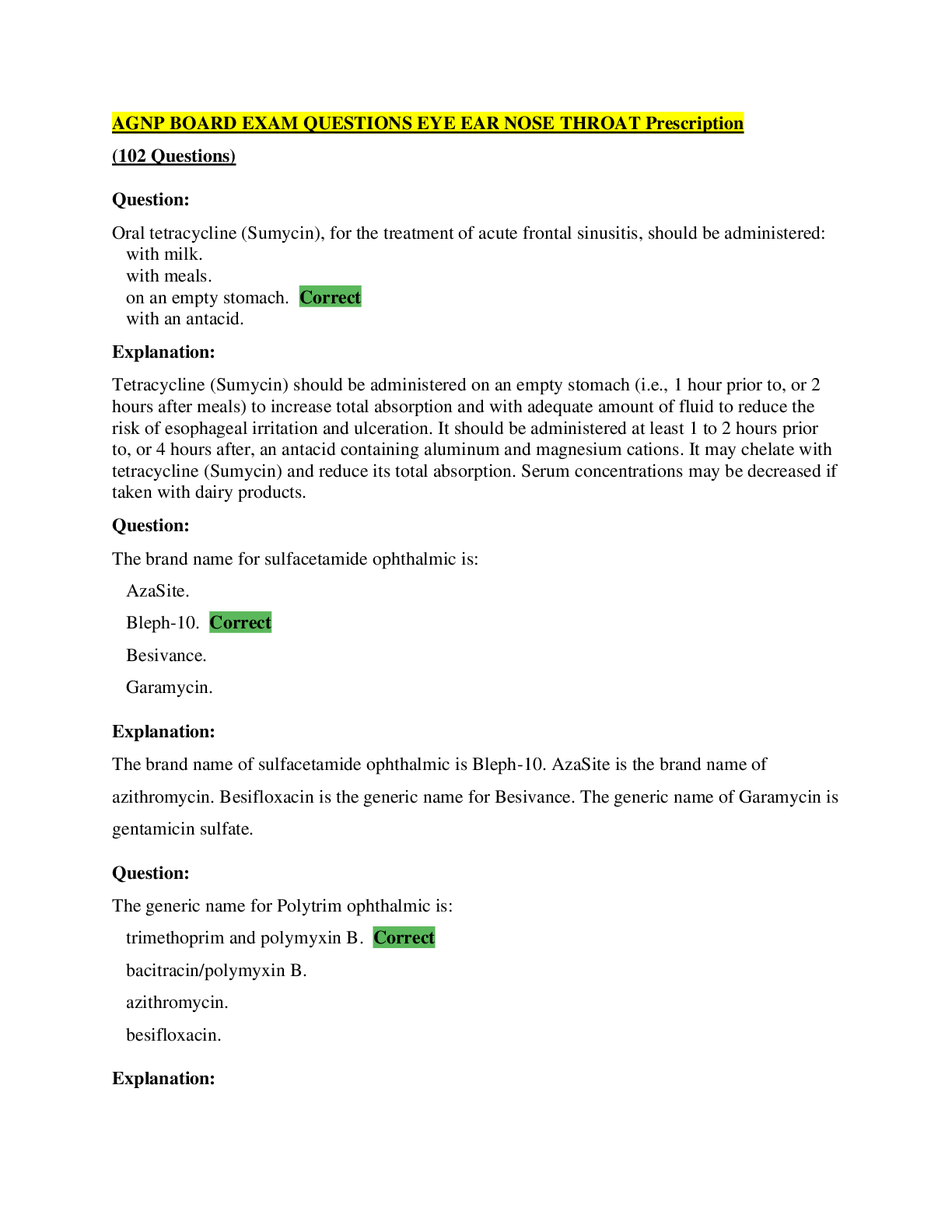*NURSING > EXAM > AGNP BOARD EXAM QUESTIONS Assessment Eye, Ear, Nose and Throat (166 Questions),100% CORRECT (All)
AGNP BOARD EXAM QUESTIONS Assessment Eye, Ear, Nose and Throat (166 Questions),100% CORRECT
Document Content and Description Below
Ophthalmoscopic examination of the fundus reveals small, rounded, slightly irregular red spots embedded in the retina. These findings are consistent with: superficial retinal hemorrhages. pr... eretinal hemorrhages. microaneurysms. deep retinal hemorrhages. Question: The whispered voice test allows the examiner to screen for: low frequency hearing loss. high frequency hearing loss. general hearing loss. conductive hearing loss. Question: On examination of the tympanic membrane, a red bulging ear drum is detected. This is consistent with: acute otitis externa. chronic otitis externa. acute otitis media. a serous effusion. Question: One of the refractive errors of vision that presents with symptoms of blurriness and improved with corrective lens, is known as: hyperopia. myopia. strabismus. astigmatism. Question: Miosis is a term used to describe: the shape of the pupils. constriction of the pupils. dilation of the pupils. symmetry of the pupils. Question: Otosclerosis is an example of a(n): conductive hearing loss. sensorineural hearing loss. mixed hearing loss. acquired hearing loss. Question: Drooping of the upper eyelid is termed: an epicanthal fold. ptosis. a retracted lid. ectropion. Question: When a light beam shines into one pupil causing pupillary constriction in that eye, the term used is: indirect reaction to light. consensual reaction to light. optic radiation. direct reaction to light. Question: Where in the mouth would reddened areas, nodules, or ulcerations that are suspicious of malignancy be present? Mucous membranes Tongue Gums Palate Question: An example of a cause of conductive hearing loss in children would be: prolonged use of tobramycin. the presence of a peanut in the ear for three weeks. congenital rubella syndrome. maternal history of Herpes infection. Question: A man with a history of long-term use of chewing tobacco presents with a mouth lesion that is suspicious for malignancy. Oral assessment findings describe: a smooth circular pustule lesion on the base of the gum. a soft, solitary papule lesion located apical to the molar. a small, shallow, sore lesion at the base of the gums. an ulcerated lesion with indurated margins on the lateral tongue. Question: Mydriasis is a term used to describe: the shape of the pupils. constriction of the pupils. dilation of the pupils. symmetry of the pupils. Question: Ophthalmoscopic examination of the retina reveals AV tapering. This appears as if the: vein "winds" down on either side of the artery. vein is twisted on the distal side of the artery. vein crosses beneath the artery. vein stops abruptly on either side of the artery. Question: Causes of sensorineural hearing loss include all of the following except: aging. loud noises over prolonged periods of time. perforated tympanic membrane. acoustic neuroma. Question: All of the following diseases may be associated with the appearance of a strawberry tongue except: scarlet fever. folic acid and B-12 deficiencies. rubeola. Kawasaki syndrome. Question: Janeway lesions of the palms and soles appear as: painful, red, raised lesions. small, nontender, erythematous nodules. hemorrhagic vesiculopustular eruptions. hemorrhagic petechiae. Question: Which of the following screening tests for hearing loss can detect both sensorineural and conductive hearing loss? Weber Test Rinne Test Whispered Voice Test bilateral hearing loss. Question: Examination of the nose and paranasal sinuses reveal local tenderness, pain, fever, and rhinorrhea. These symptoms are suggestive of: chronic sinusitis of the frontal and maxillary sinuses. allergic rhinitis. upper respiratory infection. acute sinusitis of the frontal and maxillary sinuses. Question: The mouth of a ten-month-old infant has white patches on the mucosa that cannot be removed. These patches are consistent with: stomatitis. thrush. Koplik spots. measles. Question: In patients who have allergic rhinitis, the nasal mucosa appears: erythematous. pale. green. yellow. Question: Assessment of a 4 year-olds visual acuity resulted in 20/30 in the left eye and 20/40 in the right eye using the Snellen eye chart. This means: his vision is normal for his age. his vision is abnormal and further testing is warranted. the patient may not be able to read so he should be tested with the picture or "E" eye charts. he has astigmatism. Question: Round or oval shaped lesions surrounded by erythematous mucosa and noted on an area of the oral mucosa may be: leukoplakia. aphthous ulcers. Koplik's spots. ulcerative gingivitis. Question: A deviated trachea could be caused by all of the following except: pneumothorax. pneumonectomy. pneumonia. atelectasis. Question: When examining the conjunctiva and sclera, have the patient look upward and then: cover one eye while visualizing the sclera and conjunctiva of the uncovered eye. depress both lower lids with your thumbs, exposing the sclera and conjunctiva. look for excessive tearing or dryness in the conjunctiva sac. note the position of the lids in relation to the eyeballs and color of the sclera. Question: A sixty-year-old complains of a progressive bilateral hearing loss over the past four months. He has difficulty understanding spoken words and has become sensitive to loud noises. These symptoms are consistent with: otosclerosis. mastoiditis. presbycusis. Meniere's disease. Question: In order to visualize the opening of Stensen's duct, examine the: dorsal surface of the tongue. area beneath the mandible at the angle of the jaw. buccal mucosa opposite the second molar. small openings along the sublingual fold under the tongue. Question: A condition that involves optic nerve damage and visual field changes is termed: retinoblastoma. cataracts. glaucoma. pterygium. Question: Sudden bilateral and painless visual loss is rare but can be associated with all the following except: cholinergics. anticholinergics. steroids. chemical exposure. Question: When examining pupillary equality, the left pupil is slightly greater than the right pupil. This condition is termed: miosis. anisocoria. mydriasis. conjugate. Question: Redness, bleeding, pain, and swelling of the gums is most likely: stomatitis. gingivitis. leukoplakia. aphthous ulcers. Question: A condition of the sclera that appears as localized ocular inflammation of the episcleral vessels is most likely: scleroderma. episcleritis. conjunctivitis. pinguecula. Question: When a 512 Hz tuning fork is placed over the mastoid bone and then held next to the ear canal with recordings of how long sound was heard in each ear, this is known as the: absolute bone conduction test. pure tone audiometry test. Weber test. Rinne test. Question: A patient complains of seeing specks that obscure his line of vision when he looks in a certain direction. This impairment could be caused by: vitreous floaters. retinal detachment. macular degeneration. scotomas. Question: Current indications for tympanostomy tube placement include all of the following except which one? Persistent serous otitis media (SOM) that has not responded to a 3 to 6-week course of medical treatment Recurrent acute otitis media (AOM) that does not respond to, or recurs after, antimicrobial prophylaxis Complications of acute otitis media (AOM) Complications of eustachian tube dysfunction Question: On examination of the pupils, both are round but the right pupil appears larger than the left and reacts much slower to light. This condition may be indicative of: a tonic pupil. oculomotor nerve (CN III) paralysis. Horner's syndrome. Argyll Robertson pupils. Question: Findings following assessment of a person's gaze include the inability of the left eye to look down when turned inward. This condition is most consistent with: a conjugate gaze. left cranial nerve III (oculomotor) paralysis left cranial nerve IV (trochlear) paralysis. cranial nerve VI (abducens) paralysis. Question: The acronym for pupils that are equal, round, react to light and accommodate is: PERLA. PERRLAA. PERRTLA. PERRLA. Question: On otoscopic examination, the cone of light can be visualized: at the 1 o'clock to 2 o'clock position of the left tympanic membrane. at the 4 o'clock to 5 o'clock position of the left tympanic membrane. at the 7 o'clock to 8 o'clock position of left tympanic membrane. at the 12 o'clock position of the left ear tympanic membrane. Question: The function of the auditory ossicles is to: transmit the light reflex to the light cone. transform sound vibrations into mechanical waves for the inner ear. to capture sound waves from the external ear for transmission into the middle ear. to separate the inner ear from the middle ear. Question: On the outer ear, anterior and parallel to the helix, is a curved prominence known as the: Antihelix Helix Auricle Tragus Question: A patient was diagnosed as nearsighted. The term for this condition is: hyperopia. myopia. strabismus. astigmatism. Question: The sphenoidal sinuses: are located between the eyes. surround the nasal cavity. are located above the eyes. are located behind the ethmoidal sinuses. Question: Fordyce spots or granules are considered: contagious lesions of the lip. normal sebaceous glands of the buccal mucosa. a precursor to cancer. benign lesions of the tongue. Question: The gradual loss of vision with a change in color and size of the optic disc is referred to as: macular degeneration. glaucoma. cataracts. retinoblastoma Question: The nasolacrimal duct drains into the: inferior meatus. middle meatus. superior meatus. vestibule. Question: Examination of the eye reveals a painful, erythematous, and tender area around the nose and lower eyelid. This condition is most likely: conjunctivitis. an obstructed nasolacrimal duct. dacryocystitis. pinguecula. Question: During the newborn’s physical assessment of the mouth, the soft and hard palates are palpated to detect: a tight frenulum. an opening in the palates. thrush. the presence of a tracheoesophageal fistula. Question: That portion of the ear that consists of the auricle and ear canal is the: antihelix. helix. tragus. external ear. Question: Which of the following findings in a preschooler would indicate the need for further evaluation? Intelligible speech by 24 months of age Variation in quality of speech pattern and tone Responds to facial expressions and gestures rather than to verbal explanations Looks at people when they speak Question: A 45-year-old patient complains of vertigo, tinnitus and pressure in the right ear. These symptoms are consistent with: Meniere's disease. cluster headaches. benign positional vertigo. vestibular neuronitis. Question: A patient was diagnosed as being farsighted. The term for this condition is: hyperopia. myopia. strabismus. astigmatism. Question: A 60-year-old was concerned about a yellowish colored lesion above her right eyelid. Findings revealed a slightly raised yellowish, well circumscribed plaque along the nasal area of her right eyelid. This finding is most consistent with: a pinguecula. a chalazion. episcleritis. xanthelasma. Question: The lacrimal puncta are located: in the lower conjunctival sac. in the lateral canthus of the upper eyelid. at the junction of the cornea and sclera. along the margin of the upper and lower eyelids. Question: The patient complains of seeing floating spots. This is consistent with: macular degeneration. a detached retina. glaucoma. cataracts. Question: A cyclist sustained an avulsion of the upper central incisor. If he is unable to position the tooth in the socket until he is able to be seen by a dentist, he should: transport the tooth in a cup of lukewarm tap water. place the tooth between the molars and the inside of the cheek. rinse the tooth and transport it in a clean dry cloth. not rinse the tooth but transport it in a clean dry cloth. Question: Surgical perforation of the tympanic membrane to allow drainage of middle ear secretions is termed: otosclerosis. a myringotomy. a tympanocentesis. a tympanoplasty. Question: On ophthalmoscopic examination, optic atrophy appears: pink and hyperemic. yellowish orange to creamy pink. pale. white. Question: The usual position of the trachea is located: to the left of the anterior neck and slightly above the jugular notch of the manubrium. in the middle of the anterior neck behind the jugular notch of the manubrium. to the right of the anterior neck and slightly above the jugular notch of the manubrium. in the middle of the anterior neck extending posteriorly to the sternum. Question: A patient is able to read a magazine without difficulty but cannot distinguish distant objects. This describes: hyperopia. myopia. strabismus. astigmatism. Question: Eversion of the upper eyelid can be performed by placing the cotton applicator on the upper lid above the level of the internal tarsal plates and then: gently push up with the stick and the lid will flip. gently push down with the stick and lift the lashes up and flip the lid inside out. gently place the thumbs on the lower lids and pull down to fully open the eye. gently rest the thumb and fingers on the cheek and brow, respectively, and spread the lids. Question: When inspecting the neck for the thyroid gland, slightly tilt the patient's head back, and using tangential lighting directed downward from the tip of the patient's chin, inspect the: region above the thyroid cartilage. region below the cricoid cartilage. area along the sternomastoid border. area along the anterior edge of the trapezius. Question: The conductive and sensorineural phases are necessary for hearing to take place. The conductive phase of hearing involves the: cochlea and the cochlear nerve. external auditory canal and the middle ear. ossicles and the inner ear. transfer of sounds from the external environment into the external auditory canal. Question: On ophthalmoscopic examination, glaucomatous cupping appears: pink and hyperemic. yellowish orange to creamy pink. pale. white. Question: When the corneal reflex is stimulated by shining the light in the right eye, the right eye blinks. The left eye: does not blink. blinks. turns inward. turns outward. Question: An inward turning of the lower lid margin is called: an epicanthal fold. entropion. a retracted lid. ptosis. Question: Which of the paranasal sinuses are accessible to clinical examination? Ethmoidal sinuses Sphenoidal sinuses Frontal sinuses. Vestibular sinuses Question: If a patient has a history of heat intolerance with a preference to light clothing, this behavior could be consistent with: hypothyroidism. hyperthyroidism. Hashimoto's thyroiditis. myxedema. Question: When examining the eyes, the right pupil reacts briskly to light, near effort, and is much smaller than the left pupil. This condition is mostly likely: a tonic (Adele's pupil) pupil. an oculomotor nerve (CN III) paralysis. Horner's syndrome. Argyll Robertson pupils. Question: The most common cause of bacterial pharyngeal infections in children is: Corynebacterium. Chlamydia. mononucleosis. group A beta-hemolytic Streptococcus. Question: One of the main differences between a migraine headache and a tension headache is that: migraine headaches have a rapid onset whereas, tension headaches appear gradually. nausea is usually absent with migraine headaches and present with tension headaches. migraine headaches are usually constant and do not throb; tension headaches usually throb. migraine headaches are generally bilateral and tension headaches are unilateral. Question: Ophthalmoscopic examination of the fundus reveals blood anterior to the retina and obscuring retinal vessels. These findings are consistent with: superficial retinal hemorrhages. preretinal hemorrhages. microaneurysms. deep retinal hemorrhages. Question: The most common disorder of visual acuity in children is: hyperopia. myopia. strabismus. astigmatism. Question: A teenage complains of itching and burning of his eye. Examination reveals an erythematous eyelid margin with crusting and a clear mucus discharge. These findings are consistent with: conjunctivitis. a chalazion. a corneal ulcer. blepharitis. Question: What visual acuity constitutes legal blindness? Visual acuity of 20/80 or worse bilaterally. Visual acuity of 20/200 or worse in the better eye with corrected lens. Visual acuity of 20/200 in the better eye without corrected lens. Visual acuity of 20/100 with corrected lens. Question: Examples of sudden, painful, unilateral visual loss include all the following except: retinal detachment. corneal ulcer. traumatic hyphema. acute glaucoma. Question: The function of the labyrinth in the inner ear is to: assist with air conduction. maintain equilibrium. maintain acoustic transmission. capture sound waves. Question: A 40-year-old male was umpiring a little league baseball game when he was hit in the face with flying debris. He presents with decreased vision and severe pain in the left eye. Findings reveal watery, left ocular discharge. The pupils are normal in appearance and the cornea is slightly cloudy with areas of corneal erythema. These findings are most consistent with: acute iritis. corneal injury. corneal infection. acute angle closure glaucoma. Question: Children who pick their noses are at a higher risk for development of: sinusitis. epistaxis. allergic rhinitis. purulent rhinorrhea. Question: A deviated uvula without swelling may be suggestive of a: vagus nerve lesion. peritonsillar abscess. person who smokes cigarettes. a normal finding in the elderly population. Question: The maxillary sinuses: are located between the eyes. surround the nasal cavity. are located above the eyes. are located behind the ethmoidal sinuses. Question: What part of the ear consists mainly of cartilage covered by skin and has a firm yet somewhat elastic feature? Antihelix Helix Auricle Tragus Question: When examining the pupils, the left pupil is noted to be fixed and dilated to light and near accommodation. This condition may be suggestive of: a tonic pupil. oculomotor nerve (CN III) paralysis. Horner's syndrome. Argyll Robertson pupils. Question: A term used to describe drainage from the nose is: rhinitis. rhinorrhea. cerumen. otorrhea. Question: The curved outer ridge of the auricle of the ear is known as the: Antihelix Helix Auricle Tragus Question: Eyelid retraction with exophthalmos presents as: an inward turning of the lower eyelid. an outward turning of the lower eyelid. drooping of the eyelid. a retracted eyelid with a wide-eyed stare. Question: A patient presents with complaints of earache, blood tinged discharge from the ear, and hearing loss. Findings reveal painful hemorrhagic vesicles on the tympanic membrane and the ear canal. These findings and symptoms are suggestive of: tympanosclerosis. serous effusion. otitis media with purulent effusion. bullous myringitis. Question: One cause of nasal septum perforation may be: nasal polyps. intranasal use of cocaine. cystic fibrosis. chronic sinusitis. Question: Which disorder of the eye can be detected with the cover-uncover and the Hirschberg test? Amblyopia Conjunctivitis Strabismus Cataracts Question: A patient presents with complaints of a bump on the eyelid. Findings reveal nontender, firm nodule with freely movable skin overlying the nodule. This could be consistent with: blepharitis. dacryocystitis. a hordeolum. a chalazion. Question: A 50- year-old patient complains of being unable to read the hymnal at church. This describes: hyperopia. myopia. presbyopia. astigmatism. Question: A swollen deviated uvula may be associated with a: vagus nerve lesion. peritonsillar abscess. person who smokes cigarettes. a normal finding in the elderly population. Question: Ophthalmoscopic examination of the retina reveals AV banking. This appears as if the: vein tapes down on either side of the artery. vein is twisted on the distal side of the artery. vein crosses beneath the artery. vein stops abruptly on either side of the artery. Question: Findings following assessment of a person's eye gaze include both eyes moving in the same direction simultaneously. This condition is most consistent with: a conjugate gaze. left cranial nerve III (oculomotor) paralysis cranial nerve IV (trochlear) paralysis. cranial nerve VI (abducens) paralysis. Question: A forty-five-year-old female complains of frequent attacks of dizziness accompanied by a sense of fullness in the right ear, headache, nausea, reduced hearing in the right ear. This patient may need further workup for: otosclerosis. Meniere's disease. Paget's disease. mastoiditis. Question: When comparing veins and arteries in the eyes of older adults, the arteries appear: bright red. widened. less brilliant. curvy. Question: An infant with a suspected hearing loss: communicates through gestures. sits close to the television with the volume on high. does not babble. has unintelligible speech. Question: A condition in which the eyes are not properly aligned with each other is termed: hyperopia. myopia. strabismus. astigmatism. Question: In the normal ear, all of the following landmarks can be visualized when using the otoscope, except the: ossicles. tympanic membrane. eustachian tube. cone of light. Question: Leukoplakia was noted during an exam of the mouth. This symptom may be: a normal finding. precancerous. associated with periodontal disease. consistent with gingivitis. Question: A granulomatous eyelid cyst or nodule that is painless and erythematous is termed: a hordeolum. a chalazion. keratitis. blepharitis. Question: A fine rhythmic oscillation of the eyes is termed: presbyopia. nystagmus. strabismus. proptosis. Question: Symptoms of bacterial conjunctivitis in an infant include: eyelid edema and purulent discharge from the eyes. eyelid ecchymosis and watery discharge from the eyes. vesicular rash or ulceration of eyelids with a watery discharge. contact dermatitis of the eyelids with a subconjunctival, multilobulated yellow mass. Question: A 30-year-old patient presents with a moderate "aching" in his right eye. Findings reveal a small and irregular shaped right pupil. The cornea appears cloudy with a slight erythematous area around the corneal limbus. There is no ocular discharge noted. These findings are consistent with: acute iritis. corneal injury. corneal infection. acute angle closure glaucoma. Question: The middle ear consists of: the helix, antihelix, and the tragus the malleus, incus, and the stapes the tympanic membrane, the cone of light, and the pars tensa the lobule, mastoid process, and the eustachian tube Question: A 35-year-old patient complains of vertigo accompanied by nausea and vomiting. Examination reveals bilateral diplopia and an unsteady gait. These symptoms could be suggestive of: an arrhythmia. a neurological condition. an inner ear infection. orthostatic hypotension. Question: A softening of the skin at the angles of the mouth which may be due to nutritional deficiency is commonly referred to as: actinic cheilitis. herpes simplex. angular cheilitis. leukoplakia. Question: All of the following are examples of causes of sensorineural hearing loss in children except: the presence of cerumen impaction. prolonged use of tobramycin. maternal history of Herpes infection. congenital rubella syndrome. Question: Ophthalmoscopic examination of a 30-year-old with a history of an eye injury 3 years ago, reveals a superficial grayish-white opacity in the right cornea. This may be indicative of a: corneal arcus. corneal scar. pterygium. cataract. Question: With transillumination of the maxillary sinuses, a reddish glow is observed on the hard palate. This red glow would be indicative of: thickened mucosa or secretions in the maxillary sinuses. clear maxillary sinuses. an absent maxillary sinus. a developmental absence of both maxillary sinuses. Question: Actinic cheilitis is a condition of the lower lip most commonly seen in: dark-skinned males who work in coal mines. people of all races with nutritional deficiencies. people with a history of intestinal polyps. fair-skinned men who work outdoors. Question: A 4-year-old child presents with bilateral watery discharge from the eyes. Examination reveals subconjunctival hemorrhage, and eyelid ecchymosis. These findings are consistent with: bacterial conjunctivitis. Herpes simplex viral conjunctivitis. allergic conjunctivitis. adenoviral conjunctivitis. Question: A patient complains of a sore tongue. Findings reveal a smooth and erythematous tongue. This condition is termed: gingivitis. stomatitis. glossitis. candidiasis. Question: On physical exam, an abnormal Rinne test might indicate: impaired physical mobility. impaired visual acuity. impaired hearing ability. impaired swallowing ability. Question: The fleshly projection of the earlobe is known as the: lobule. tragus. auricle. helix. Question: Examination of the nasolacrimal duct reveals a mucopurulent discharge from the puncta. This finding is suggestive of: conjunctivitis. an obstructed nasolacrimal duct. dacryocystitis. pinguecula. Question: To palpate for frontal sinus tenderness, press up on the frontal sinuses from under the bony brows, then: press down on the ethmoid sinus. press up on the maxillary sinus. palpate around the orbit. observe the turbinates. Question: A nodular protuberance that points backward over the entrance to the ear canal is called the: Antihelix Helix Auricle Tragus Question: A 60- year-old patient presents with severe, deep left eye pain. Findings reveal dilated and fixed left pupil and the cornea is cloudy. There is no ocular discharge noted. These findings are most likely consistent with: acute iritis. corneal injury. corneal infection. acute angle closure glaucoma. Question: A patient presents with findings of pain, warmth, redness, and swelling below the inner canthus toward nose. Tearing is present and when pressure is applied to the lacrimal sac, purulent discharge from the puncta is noted. This is suggestive of: blepharitis. dacryocystitis. a hordeolum. a chalazion. Question: When assessing extraocular movements: use the Snellen eye chart. use the ophthalmoscope to view the fundus. include the cardinal directions of gaze. shine a penlight into the pupils. Question: Ptosis is defined as: an inward turning of the lower eyelid. an outward turning of the lower eyelid. drooping of the eyelid. a retracted eyelid with a wide-eyed stare. Question: When a person shifts gaze from a near object to a far object, the pupils: dilate. constrict. remain unchanged. depends. Question: Assessment of a patient's visual acuity resulted in 20/200 using the Snellen eye chart. This means that: at 200 feet the patient can read printed information that a person with normal vision could read at 20 feet. at 20 feet the patient can read printed information that a person with normal vision could read at 200 feet. the patient has normal visual acuity. the patient may not be able to read so he should be tested with the picture or "E" eye charts. Question: A 57-year-old man with a history of diabetes complains of difficulty hearing on the telephone and muffled sounds while watching the television at a low volume. He should be further evaluated for: acoustic neuroma. granulomatous disease. cholesteatoma. presbycusis. Question: Ophthalmoscopic examination reveals dark specks noted between the fundus and the lens. These specks are most likely: superficial retinal hemorrhages. cataracts. drusen. vitreous floaters. Question: What connects the middle ear to the nasopharynx? The tympanic membrane The proximal end of the eustachian tube The malleus The ossicles Question: Upon examination of the right tympanic membrane, a cone of light was visible at the four o'clock mark. This would be interpreted as: a perforation of the ear drum. an acute otitis media. a normal eardrum. tympanosclerosis. Question: When examining the eyes, both pupils appear small and have an irregular shape. They are noted to accommodate but do not appear to react to light. This could be indicative of: a tonic (Adele's pupil) pupil. oculomotor nerve (CN III) paralysis. Horner's syndrome. Argyll Robertson pupils. Question: Ectropion is defined as: an inward turning of the lower eyelid. an outward turning of the lower eyelid. drooping of the eyelid. a retracted eyelid with a wide-eyed stare. Question: Gingival hyperplasia could be seen in all the following conditions except: those patients undergoing phenytoin (Dilantin) therapy. adolescents with nickel braces. in patients diagnosed with diabetes. in adults with leukemia. Question: A 30-year-old patient presents with complaints of seeing double in the right eye. Examination reveals diplopia in the right eye when the left eye is closed. This may be suggestive of a: problem in the cornea. problem in the optic disc. palsy of cranial nerve III or IV. palsy of cranial nerve III or VI. Question: A deposit of uric acid crystals appearing as hard nodules on the helix or antihelix is termed: a keloid. a tophi. a cutaneous cyst. chondrodermatitis. Question: A patient presents with complaints of burning, itching, tearing, and some pain in the eye. Findings reveal red, scaly, greasy flakes and thickened, crusted lid margins. This would be suggestive of: a chalazion. blepharitis. a hordeolum. dacryocystitis. Question: An eight-year-old complains of itching in the right ear and an increase in pain when the pinna is pulled or the tragus is palpated. Examination reveals slight redness in the ear canal with a clear odorless fluid. This could be suggestive of: otitis media. otitis externa. mastoiditis. a tympanic membrane rupture. Question: If there is an abnormal protrusion, what condition should be suspected if there is an abnormal protrusion of the eyes? Hypothyroidism cataracts. Graves' disease Glaucoma Question: Sudden visual loss suggests: retinal detachment. hyperopia. macular degeneration. hyperglycemia. Question: A six-year-old child presents with sore throat, difficulty swallowing, and a temperature of 102 °F. Findings reveal lymphadenopathy and pharyngeal erythema. This is probably: sinusitis. exudative tonsillitis. pharyngitis. the flu. Question: A toddler with a suspected hearing loss would: exhibit little or no babbling or vocalization sounds. likely communicate through gestures. display poor school performance. need to watch television with the volume on high. Question: A reduction in vision in one or both eyes causing loss of binocular vision is termed: strabismus. amblyopia. cataracts. macular degeneration. Question: The Rinne hearing test allows the examiner to screen for: sensorineural hearing loss. conductive hearing loss. general hearing loss bilateral hearing loss. Question: A patient is able to recognize distant objects but has difficulty reading a book's small print. This describes: hyperopia. myopia. strabismus. astigmatism. Question: On ophthalmoscopic exam of the older adult, there is an increased cup-to-disc ratio: This finding is suggestive of: cataracts. macular degeneration. open angle glaucoma. blindness. Question: The majority of people who present with non-24 hour sleep-wake disorder are: legally blind. attention deficit. color blind. totally blind. Question: A person who has been blind since birth presents for a physical exam. Expected findings of the pupillary reaction when light is shown would be: constriction of both pupils. dilation of both pupils. no reaction from either pupil. it depends. Question: A localized Staphylococcal infection of the hair follicles at the lid margin is suggestive of: a hordeolum. blepharitis. a chalazion. dacryocystitis. Question: Ophthalmoscopic examination of the fundus reveals tiny, round, red spots in and around the macular area. These findings are consistent with: superficial retinal hemorrhages. preretinal hemorrhages. microaneurysms. deep retinal hemorrhages. Question: When administering ear drops to a 6-year-old, the pinna should be pulled: downward. downward and back. upward. upward and back. Question: Sudden bilateral and painful visual loss is rare but can be associated with: cholinergics. anticholinergics. steroids. radiation exposure. Question: Performance of the Weber and Rinne tests to assess for hearing loss is best performed using tuning fork with a frequency of: 256 Hz. 512 Hz. 800 Hz. 1000Hz. Question: To visualize the ear canal and the tympanic membrane of an adult, use the otoscope with: the largest ear speculum the canal will accommodate. the smallest ear speculum. a pneumatic bulb. slight pressure with the speculum directed in an upward motion. Question: A six-year-old complains that something is in her left eye. There is a red raised area of the left lid. There is redness and tenderness of the eye and tearing. These findings are consistent with: blepharitis. conjunctivitis. a corneal ulcer. a hordeolum. Question: A 40-year-old patient presents with complaints of seeing double bilaterally. Examination reveals a horizontal diplopia. This may be suggestive of a: problem in the cornea. problem in the lens. palsy of cranial nerve III or IV. palsy of cranial nerve III or VI. Question: The ethmoidal sinuses: are located between the eyes. are located above the eyes. surround the nasal cavity. are located behind the sphenoid sinuses. Question: The ossicles are located in the: inner ear. middle ear. auditory canal. external ear. Question: A 50-year-old patient presents with complaints of seeing double bilaterally. Examination reveals a vertical diplopia. This may be suggestive of a: problem in the cornea. problem in the lens. palsy of cranial nerve III or IV. palsy of cranial nerve III or VI. Question: If a patient complains of seeing flashing lights across the field of vision, this could be: a normal response if around bright lights. a retinal detachment. detachment of the vitreous from the retina. lesion in the visual pathways. Question: A buildup of excess fluid around the periphery of the eye orbits is known as: episcleritis. pinguecula. ptosis. periorbital edema. Question: A child presents with a complaint of a left earache that worsens with head movement. Findings on examination include temperature of 102 °F, cellulitis behind the left ear. These findings are consistent with: otitis externa. otitis media. mastoiditis. otosclerosis. Question: On ophthalmoscopic examination of a 70-year-old, a thin grayish white arc is noted on the lower end of the cornea. This appearance is referred to as a: corneal arcus. corneal scar. pterygium. cataract. Question: Ophthalmoscopic examination of the retina reveals a normal arteriovenous crossing. This appears as if the: vein tapers down on either side of the artery. vein is twisted on the distal side of the artery. vein crosses beneath the artery. vein stops abruptly on either side of the artery. Question: In order to examine the tongue, ask the patient to stick out his tongue and with the examiner's right hand: stimulate the patient to cough. pull the tongue downward and push down with the finger on the left hand to elicit the gag reflex. grasp the tip of the tongue, gently pull it to the left side , and inspect the side of the tongue. inspect it for symmetry. Question: Most of the paranasal sinuses drain into the: inferior meatus. middle meatus. superior meatus. vestibule. Question: Raised or flat, deep purple colored lesions noted in the mouth may be suggestive of: Koplik's spots. Kaposi's sarcoma. torus palatinus. Fordyce spots. Question: Findings following assessment of a person's left eye gaze include impaired movements when attempting to look upward, downward, or inward. This condition is most consistent with: a conjugate gaze. left cranial nerve III (oculomotor) paralysis cranial nerve IV (trochlear) paralysis. cranial nerve VI (abducens) paralysis. Question: With transillumination of the frontal sinuses, a dim red glow is observed on the forehead. This dim red glow would be indicative of: thickened mucosa or secretions in the frontal sinuses. clear frontal sinuses. an absent frontal sinus. a developmental absence of both frontal sinuses. . Question: All of the following symptoms in a 10-month-old would be indicative of acute otitis media (OM)except: nausea, vomiting, and possibly diarrhea increased mobility of the tympanic membrane persistent crying and irritability reluctance to suck a bottle [Show More]
Last updated: 1 year ago
Preview 1 out of 93 pages
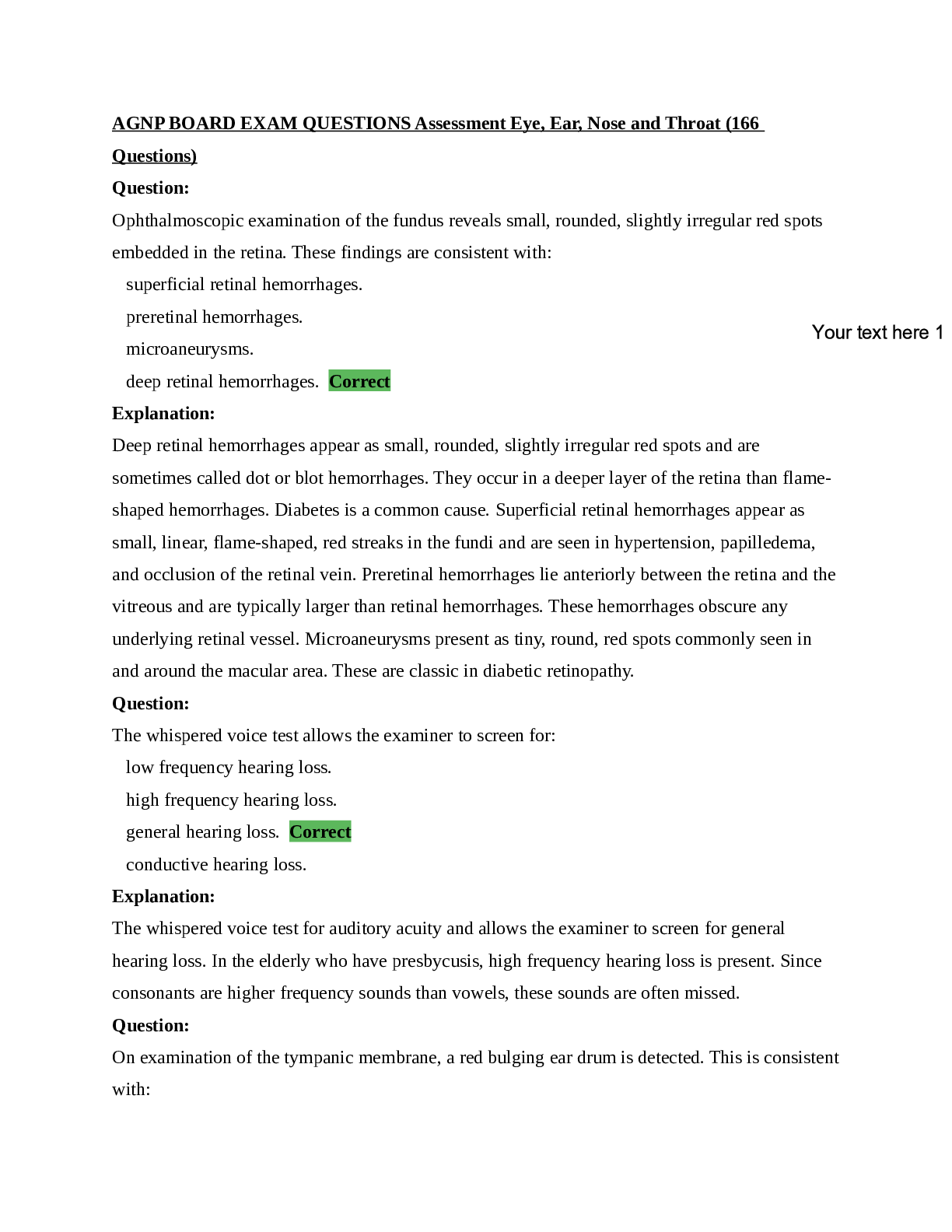
Reviews( 0 )
Document information
Connected school, study & course
About the document
Uploaded On
Jan 20, 2021
Number of pages
93
Written in
Additional information
This document has been written for:
Uploaded
Jan 20, 2021
Downloads
0
Views
66




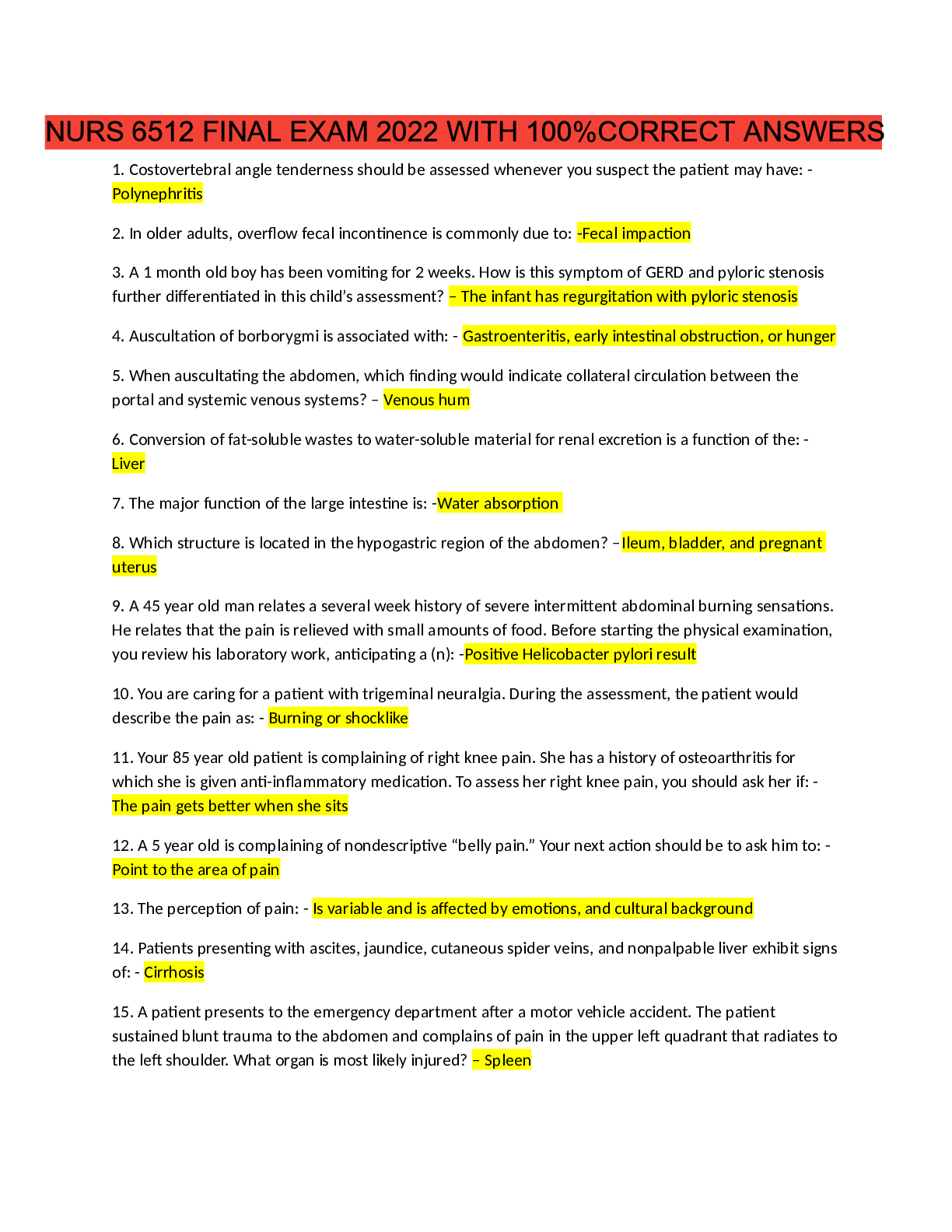

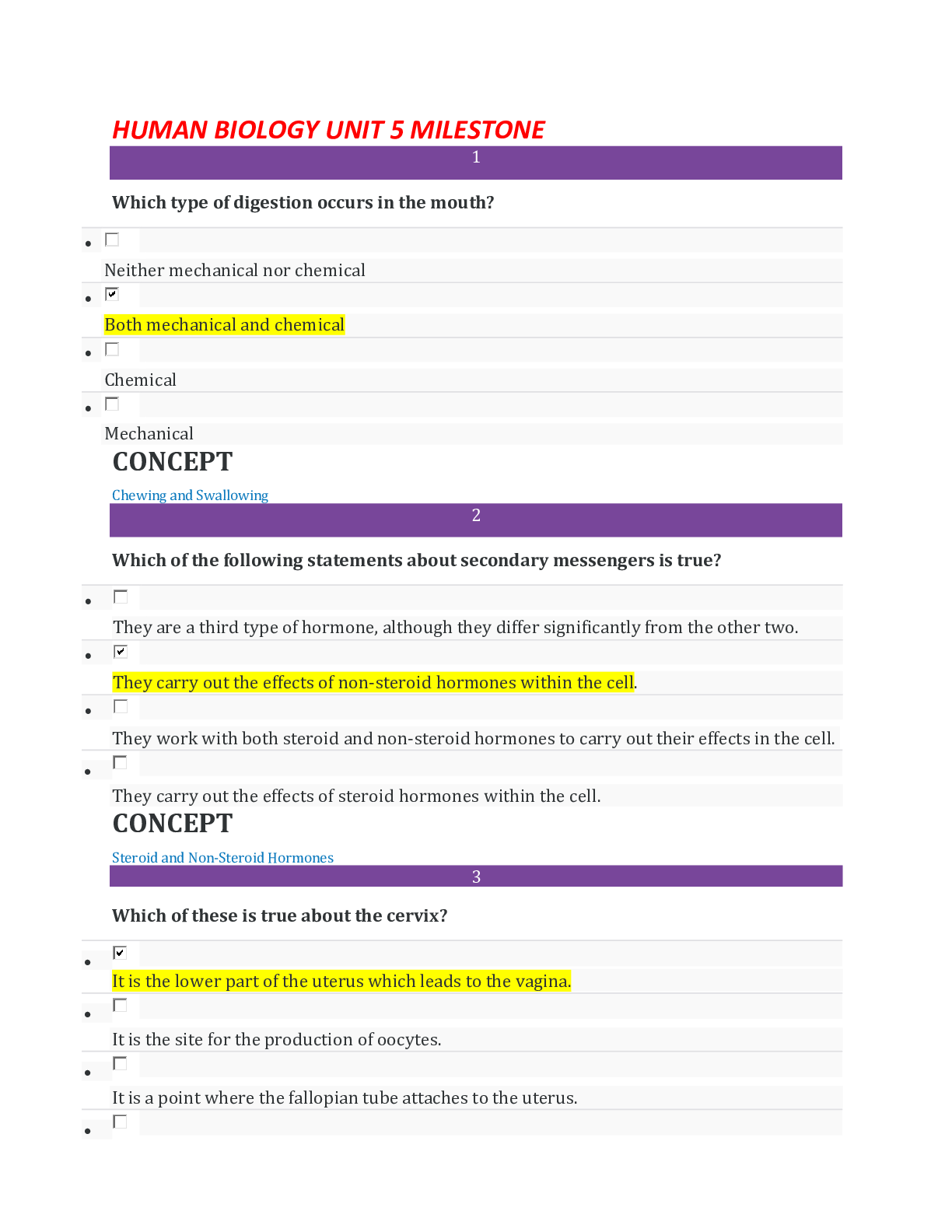












 Assessment Eye, Ear, Nose and Throat (166 Questions) – South University Savannah.png)
